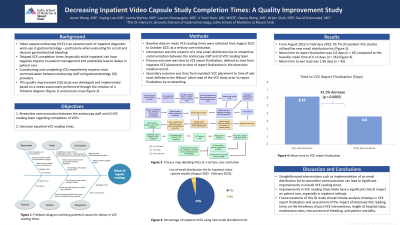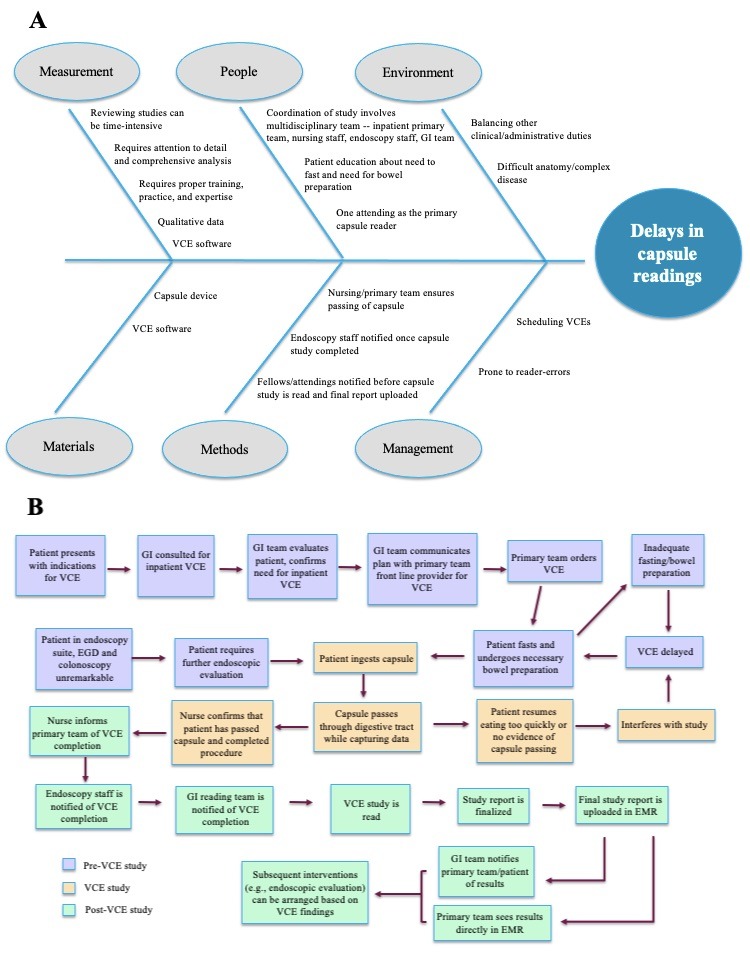Tuesday Poster Session
Category: Practice Management
P4092 - Decreasing Inpatient Video Capsule Study Completion Times: A Quality Improvement Study
Tuesday, October 24, 2023
10:30 AM - 4:00 PM PT
Location: Exhibit Hall

Has Audio
- AW
Aaron Wong, MD
Icahn School of Medicine at Mount Sinai
New York, New York
Presenting Author(s)
Aaron Wong, MD1, Yuying Luo, MD2, Jamila Wynter, MD1, Lauren Donnangelo, MD1, Ji Yoon Yoon, MD, MSCR1, Jennifer Jo, MD1, Danny Wong, MD1, Brijen Shah, MD1, David Greenwald, MD1
1Icahn School of Medicine at Mount Sinai, New York, NY; 2Center of GI Physiology and Motility at Mount Sinai West, New York, NY
Introduction: Video capsule endoscopy (VCE) is an essential part of the inpatient work-up for occult and obscure gastrointestinal bleeding. Coordinating and completing these studies expediently requires close communication between endoscopy staff and gastroenterologists. We aimed to create a structured VCE reading process to streamline communication and decrease reading times for inpatient VCEs.
Methods: This was a quality improvement (QI) project undertaken at a tertiary care institution with the primary aim of improving reading times for inpatient VCEs. The primary outcome was time to VCE report completion, defined as time from inpatient VCE placement to time of report finalization in the electronic medical record (EMR). A secondary outcome was time from inpatient VCE placement to time of the “wet read”, defined as the fellows’ initial read of the VCE study prior to report finalization by an attending. Baseline data were collected from August 2021 to October 2021 and a fishbone diagram (Figure A) and process map (Figure B) were created to identify potential areas for improvement. The intervention was the creation of a new email distribution list dedicated to VCE studies for streamlined notification between endoscopy staff and gastroenterologists as VCEs were completed.
Results: Data from August 2022 to February 2023 revealed that the email distribution list was used in 95.7% of inpatient VCEs. Of the inpatient VCEs that utilized the email distribution list, the mean time to VCE report finalization was 3.6 days (n = 45) compared to the baseline mean time of 6.15 days (n = 26). This represents a 41.5% decrease (p = 0.0005) in time to VCE report finalization. The mean time to initial wet read report was 1.96 days (n = 45).
Discussion: Straightforward interventions such as implementation of an email distribution list to streamline communication can lead to significant improvements in overall VCE reading times. This is particularly important in inpatient settings as this can help expedite the timing of post-VCE clinical management decisions such as additional endoscopic interventions or imaging studies when warranted. This, in turn, can likely also help reduce the length of hospital admissions. Future iterations of this QI project will include analysis of delays in report finalization into the EMR and assessment of the impact of improved VCE reading times on the timeliness of post-VCE interventions when warranted, length of hospital stays, readmission rates, and patient mortality.

Disclosures:
Aaron Wong, MD1, Yuying Luo, MD2, Jamila Wynter, MD1, Lauren Donnangelo, MD1, Ji Yoon Yoon, MD, MSCR1, Jennifer Jo, MD1, Danny Wong, MD1, Brijen Shah, MD1, David Greenwald, MD1. P4092 - Decreasing Inpatient Video Capsule Study Completion Times: A Quality Improvement Study, ACG 2023 Annual Scientific Meeting Abstracts. Vancouver, BC, Canada: American College of Gastroenterology.
1Icahn School of Medicine at Mount Sinai, New York, NY; 2Center of GI Physiology and Motility at Mount Sinai West, New York, NY
Introduction: Video capsule endoscopy (VCE) is an essential part of the inpatient work-up for occult and obscure gastrointestinal bleeding. Coordinating and completing these studies expediently requires close communication between endoscopy staff and gastroenterologists. We aimed to create a structured VCE reading process to streamline communication and decrease reading times for inpatient VCEs.
Methods: This was a quality improvement (QI) project undertaken at a tertiary care institution with the primary aim of improving reading times for inpatient VCEs. The primary outcome was time to VCE report completion, defined as time from inpatient VCE placement to time of report finalization in the electronic medical record (EMR). A secondary outcome was time from inpatient VCE placement to time of the “wet read”, defined as the fellows’ initial read of the VCE study prior to report finalization by an attending. Baseline data were collected from August 2021 to October 2021 and a fishbone diagram (Figure A) and process map (Figure B) were created to identify potential areas for improvement. The intervention was the creation of a new email distribution list dedicated to VCE studies for streamlined notification between endoscopy staff and gastroenterologists as VCEs were completed.
Results: Data from August 2022 to February 2023 revealed that the email distribution list was used in 95.7% of inpatient VCEs. Of the inpatient VCEs that utilized the email distribution list, the mean time to VCE report finalization was 3.6 days (n = 45) compared to the baseline mean time of 6.15 days (n = 26). This represents a 41.5% decrease (p = 0.0005) in time to VCE report finalization. The mean time to initial wet read report was 1.96 days (n = 45).
Discussion: Straightforward interventions such as implementation of an email distribution list to streamline communication can lead to significant improvements in overall VCE reading times. This is particularly important in inpatient settings as this can help expedite the timing of post-VCE clinical management decisions such as additional endoscopic interventions or imaging studies when warranted. This, in turn, can likely also help reduce the length of hospital admissions. Future iterations of this QI project will include analysis of delays in report finalization into the EMR and assessment of the impact of improved VCE reading times on the timeliness of post-VCE interventions when warranted, length of hospital stays, readmission rates, and patient mortality.

Figure: Figure A: Fishbone diagram
Figure B: Process map
Figure B: Process map
Disclosures:
Aaron Wong indicated no relevant financial relationships.
Yuying Luo indicated no relevant financial relationships.
Jamila Wynter indicated no relevant financial relationships.
Lauren Donnangelo indicated no relevant financial relationships.
Ji Yoon Yoon indicated no relevant financial relationships.
Jennifer Jo indicated no relevant financial relationships.
Danny Wong indicated no relevant financial relationships.
Brijen Shah indicated no relevant financial relationships.
David Greenwald indicated no relevant financial relationships.
Aaron Wong, MD1, Yuying Luo, MD2, Jamila Wynter, MD1, Lauren Donnangelo, MD1, Ji Yoon Yoon, MD, MSCR1, Jennifer Jo, MD1, Danny Wong, MD1, Brijen Shah, MD1, David Greenwald, MD1. P4092 - Decreasing Inpatient Video Capsule Study Completion Times: A Quality Improvement Study, ACG 2023 Annual Scientific Meeting Abstracts. Vancouver, BC, Canada: American College of Gastroenterology.
